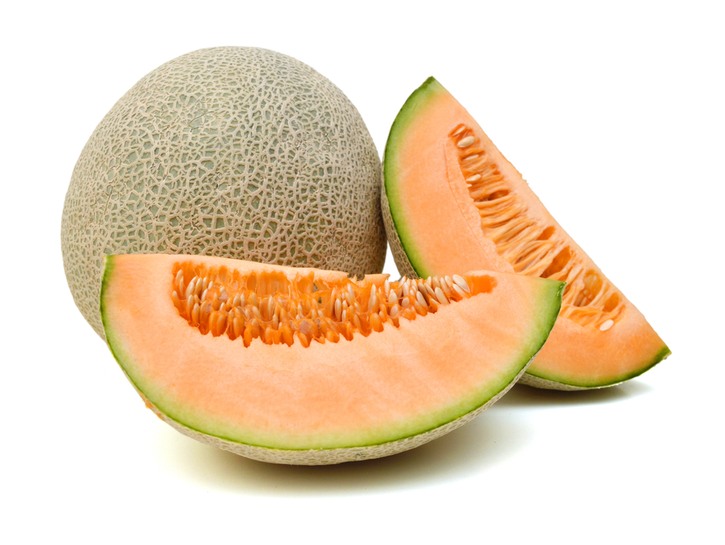You’re at the grocery store filling up your cart when you make your way over to the produce section. You’re thinking you could be feeling cantaloupe this week, but the last time you bought one, you cut it open at home and found it full of bitter-smelling mush. Looking over at the melon pyramids, you see other shoppers handling the melons kind of strangely. One person’s tapping a cantaloupe, another looks like they’re sniffing the underside of it. Are you missing something here?
Cantaloupes are not only sweet and delicious, but they’re a great source of vitamin A and vitamin C. One serving (a quarter of a medium-size melon) provides over 400% of your daily vitamin A, and almost 100% of vitamin C at only 50 calories per 6-once slice.

How To Identify The Perfect Cantaloupe
Look
The perfect cantaloupe will have a raised netting pattern of a creamy beige color. The rind underneath the textured netting can be anywhere from yellow, tan, to cream-colored, but a green or greenish-grey rind covered by flat netting means the cantaloupe is not ripe.
Avoid cantaloupes with brown or black spots, dents, bruises, holes, or wet, leaking ends. Melons with some discoloration are okay, since this is likely just the spot where the melon rested on the ground or was exposed to excess sunlight. Cantaloupes are grown in soil, so white discolorations are normal and will not affect taste.
Feel
You should be able to feel the netted or webbed texture on the outside of the melon – smooth skin is bad news, unless it’s restricted to a single patch where the melon was probably touching the ground. A ripe cantaloupe will be firm to the touch but not rock hard. You should be able to gently press down on the melon skin without feeling soft or mushy patches. (Do not press too hard on the cantaloupe, as this may cause bruising!) A ripe cantaloupe is likely to also feel heavier than it looks when you go to pick it up.
Sound
A ripe melon can be tapped or knocked lightly and produce a low, deep sound, while a higher, more hollow sound is a bad sign.
Smell
A great trick for determining cantaloupe ripeness is checking the bottom of the cantaloupe (called the “the blossom end”, opposite from the part where the stem was attached) for a pleasant, fragrant smell. A perfectly ripe cantaloupe will have a floral, fresh cantaloupe aroma, whereas an unripe cantaloupe will typically have no smell or a very faint smell. An overwhelmingly strong smell tends to indicate an overripe, fermenting cantaloupe. Beware the scent of alcohol or acetone (nail polish remover smell), as this means the melon you’re sniffing has begun fermenting inside and will be unpleasantly mushy.
Healthy Features To Look For
When cantaloupes are ripe and ready to be harvested, the melon will naturally slip off the vine and produce a clean depression where the stem was connected. When shopping for cantaloupes, look for smooth, round ends where the stems have detached evenly. Avoid cantaloupes with jagged, torn, or lumpy stem remnants protruding from the melon, since these melons were harvested too early and will not be very sweet or flavorful.

How To Store A Cantaloupe
After bringing the perfect cantaloupe home, you may wonder how long it’s going to stay perfect. Don’t worry! With proper refrigeration, you have about a week to cut and eat your cantaloupe without it losing freshness.
Before Cutting It
For best results, melons fresh from the store should be refrigerated for five to seven days, depending on the initial ripeness when purchased. If you deliberately buy a cantaloupe that’s not yet fully ripe, it can be stored at room temperature for a few days while it ripens further. Do not store cantaloupe in the freezer.
After Cutting It
Once you’ve cut open and sliced a cantaloupe, return it to the fridge wrapped tightly in plastic. It’s best to keep the seeds in the melon to prevent the flesh from drying out. Try your best to eat your remaining cantaloupe over the course of the next one or two days. Pieces of cantaloupe left unrefrigerated for more than two hours should be discarded.
